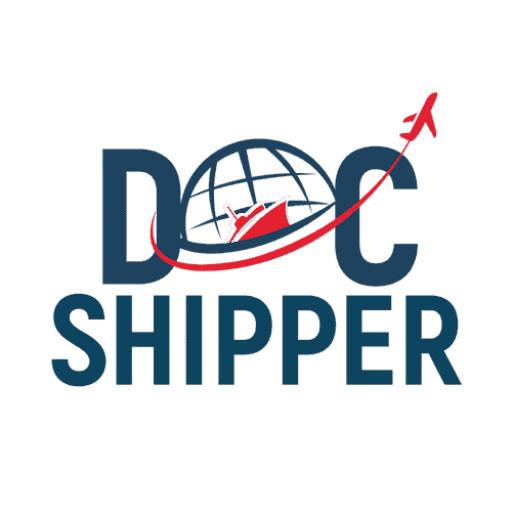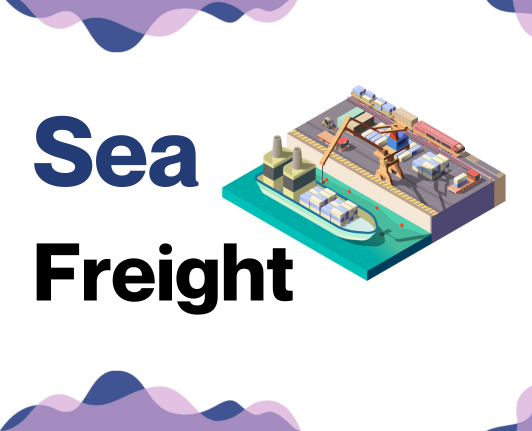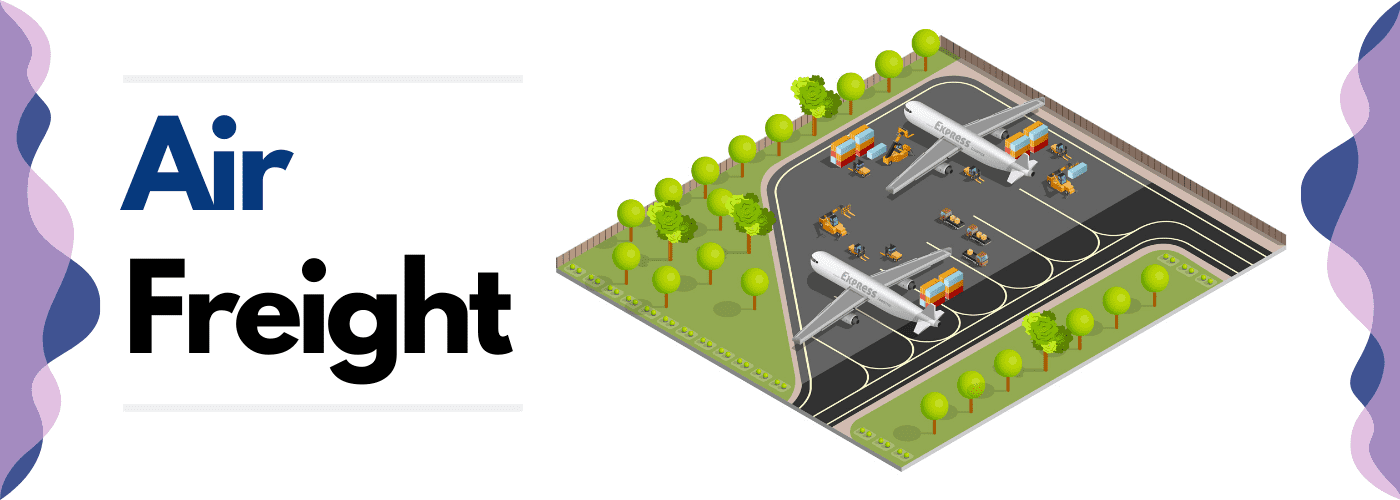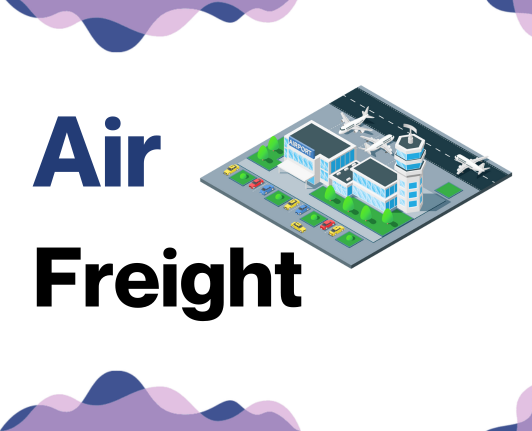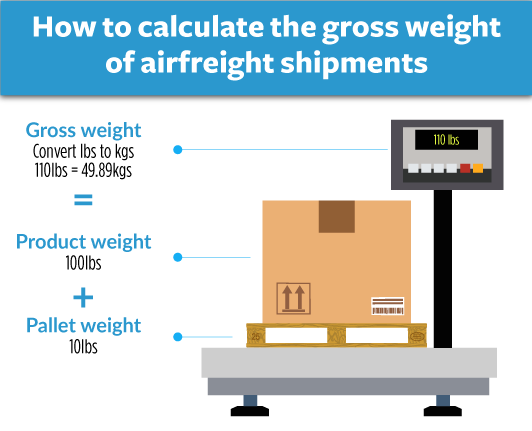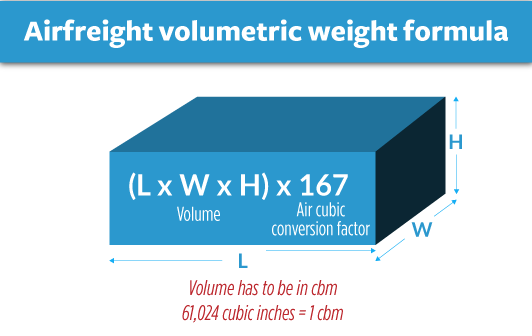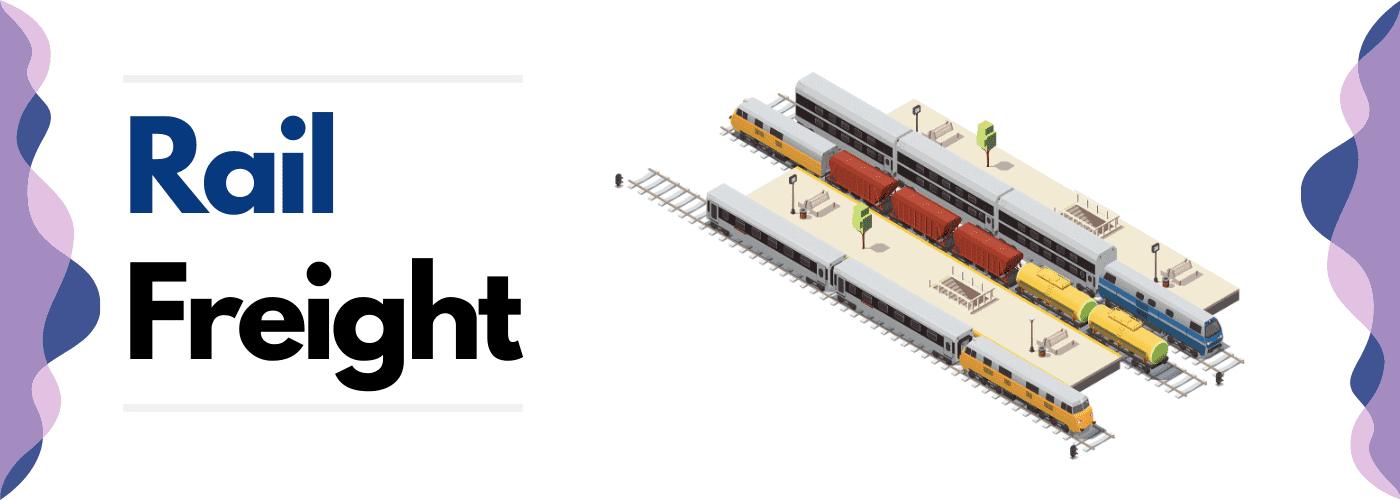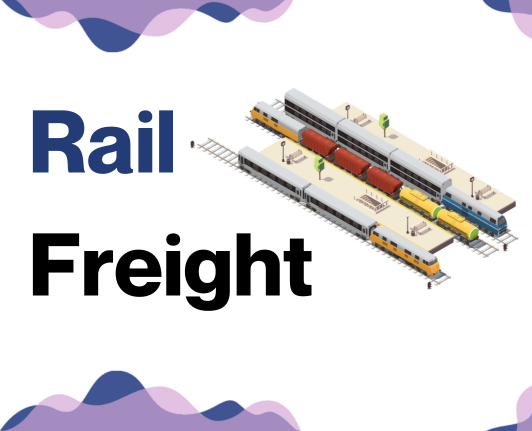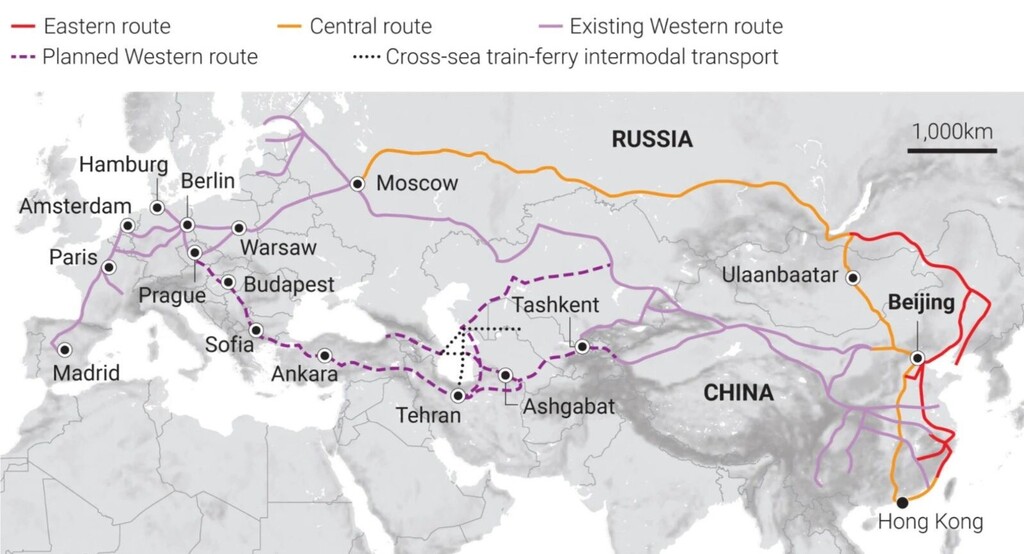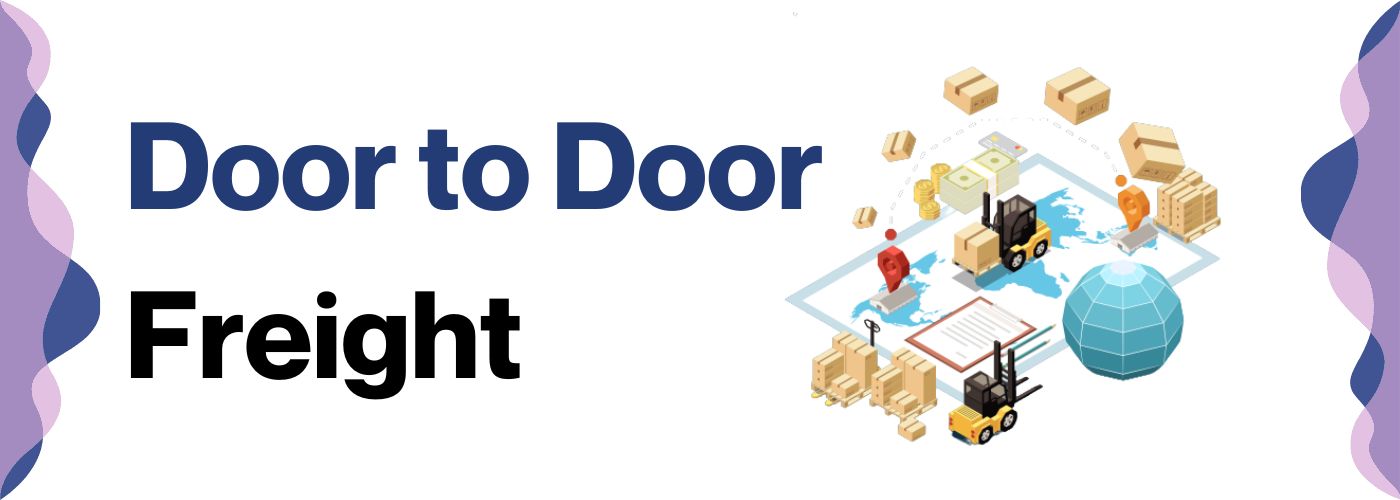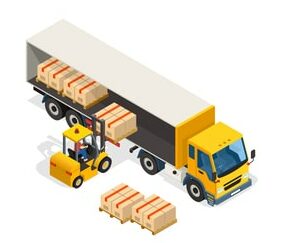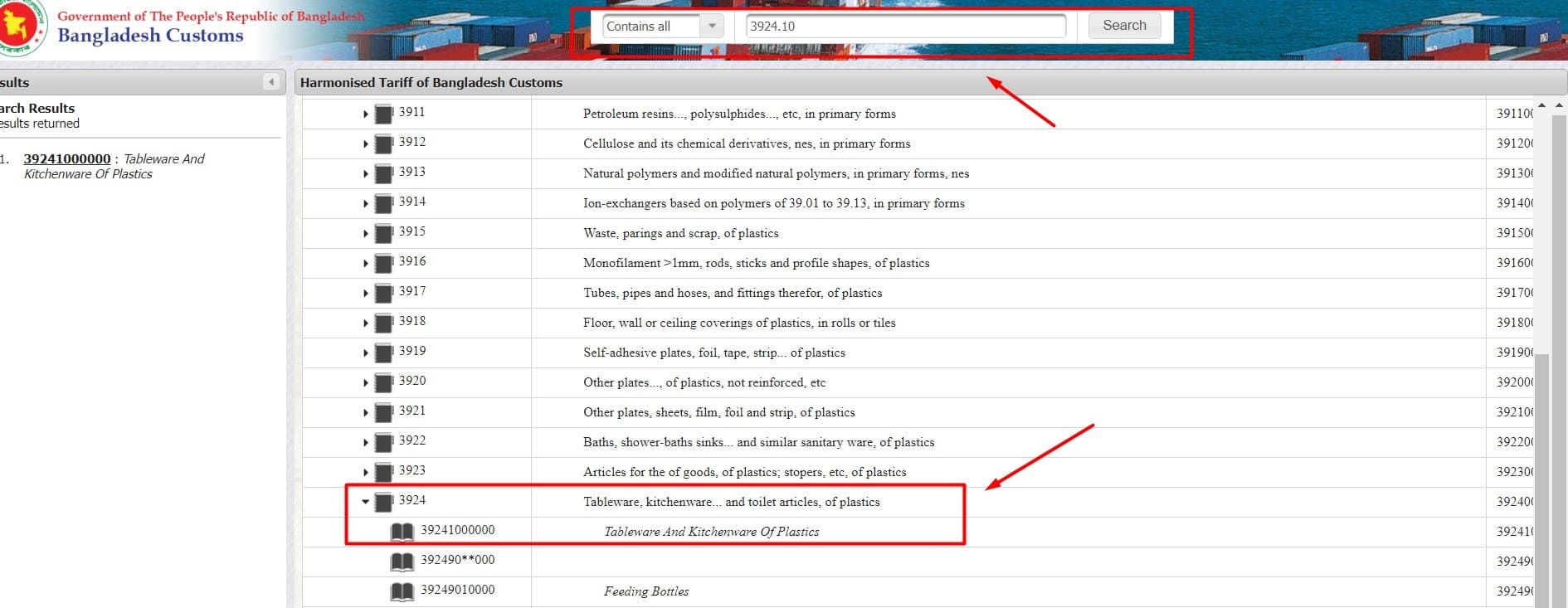Ever tried playing 'pin the container on the cargo ship' blindfolded? Well, figuring out freight transport between China and Bangladesh can often feel just as dizzying. Businesses can find it tough to decipher shipping rates, estimate transit times, or untangle the web of customs regulations. But there's no need to panic.
This comprehensive guide will shed light on the different types of freight options available and guide you through the complex world of customs clearance, duties, and taxes, serving bespoke advice for your business needs.
If the process still feels overwhelming, let DocShipper handle it for you! As a seasoned provider of end-to-end shipping solutions, DocShipper transforms all these challenges into success for your business. Let this guide be your compass to uncomplicated, worry-free international freight transport.
Which are the different modes of transportation between China and Bangladesh?
Crisscrossing the vast landscape and bustling cities between China and Bangladesh can seem like navigating a high-stakes board game. Picture it almost like a life-sized version of Monopoly, where the dice rolls decide whether to ship by air, sea, road, or rail.
With towering mountains to cross and winding sea routes, road and sea transport emerge as practical choices. Much like choosing to buy a railway station or opt for a swift flight in Monopoly, each choice could be a game-changer for your business, depending on the nature of your cargo and delivery deadlines. Make your move wisely, folks!
How can DocShipper help?
Shipping from China to Bangladesh? DocShipper streamlines the process with expert handling of customs duties, paperwork, and best transport routes. Benefit from our expertise to ensure a hassle-free experience. Don’t guess, trust the experts. Get your free estimate or dial our consultants for free guidance.
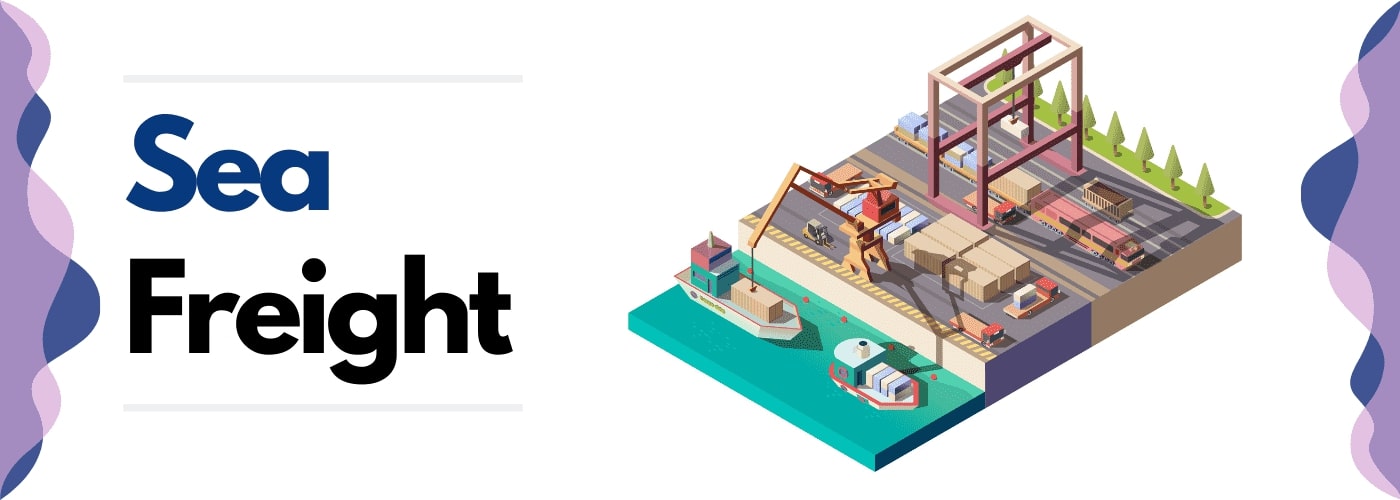
![]()
DocShipper Tip: Sea freight might be the best solution for you if:
- You are shipping large volumes or bulky items, as sea freight offers the most space at a cost-effective rate.
- Your cargo doesn't have an urgent deadline, as sea freight typically has longer transit times compared to air or rail.
- Your shipping routes are between major ports, allowing you to leverage the extensive global network of sea shipping lanes.
Sea freight between China and Bangladesh
When it comes to the global trade landscape, the robust relationship between China and Bangladesh is a vital apex, particularly through the sea lanes. Key cargo ports like Chittagong in Bangladesh and Shanghai in China form the backbone of this connection, knitting together their primary industrial hubs.
While sea freight syncs with the rhythm of these economies, it's the most affordable choice for transporting large volumes of goods.
But let's not sugarcoat the process – sea shipping between these two giants stirs up a sea of complexities. Picture trying to sync two different watches glistening in their unique time zones – that's the kind of challenge businesses face while managing shipping logistics.
Innumerable shippers have been swamped by issues ranging from duties, and customs to compliance. Fear not, though - this section illuminates a trove of best practices and specifications skillfully equipping you to steer clear of these pitfalls. Perfectly synchronizing your shipping tasks could be as satisfactory as playing a well-tuned piano! Just tune in.
Main shipping ports in China
Port of Shanghai
Location and Volume: In the initial four months of 2023, the Port of Shanghai, situated on the eastern coast of China in Shanghai, emerged as the globe's most bustling harbor. Boasting a remarkable performance, it efficiently managed a staggering 47.3 million TEUs of container cargo. This marked an impressive 30.2% growth from the preceding year, underscoring its pivotal role in global maritime commerce. Amid China's post-COVID-19 economic resurgence, this expansion serves as a testament to the nation's resilience and the unwavering commitment of the port to seamlessly navigate the intricacies of international trade.
Key Trading Partners and Strategic Importance: Key trading partners include the United States, Europe, and other APAC countries. The complete container throughput makes the port a significant gateway for foreign trade, particularly for businesses operating on a global level.
Context for Businesses: If you're looking to expand your business and need extensive global access, the Port of Shanghai should figure prominently in your shipping strategies given its comprehensive reach and high frequency of departures to a wide range of locations.
Ningbo-Zhoushan Port
Location and Volume: Ningbo-Zhoushan Port, situated in Zhejiang province, China, performed exceptionally well in 2022, handling 15 million TEUs of container cargo—a 7.3% increase from the previous year—and earning the third spot among the busiest container ports worldwide. In addition, the port achieved an astounding throughput of 1.25 billion tons of cargo, maintaining its title as the world's best port for a record 14 years. The sea-rail container intermodal transport sector saw a notable 20% growth at the port, reaching a volume of 1.45 million TEUs.
Key Trading Partners and Strategic Importance: The port is in a crucial location for trans-Pacific and intra-Asia trade and services to key partners such as the US, Europe, and other East Asia countries.
Context for Businesses: If you operate in heavy industries such as iron, steel or crude oil, Ningbo-Zhoushan's high capacity for cargo throughput could play a pivotal role in your logistics chain due to its expertise in handling bulky commodities.
Port of Shenzhen
Location and Volume: Shenzhen Port, which is part of the Guangdong-Hong Kong-Macao Greater Bay Area, handled an incredible 13.5 million TEUs per year—a 4.39% increase from the year before. This was a historic achievement. Shenzhen has become a major shipping hub due to its strategic initiatives and economic resilience, making it the fourth port in the world to handle over 13.5 million TEUs. A few of the innovative strategies that have aided in the port's success include the establishment of transshipment routes, the use of sea-rail transit, and the introduction of international freight routes.
Key Trading Partners and Strategic Importance: This port has strong connections with major shipping hubs in APAC, Europe, and the Americas regions. As Shenzhen is a robust manufacturing region, the port is central to outbound movements of goods.
Context for Businesses: The Port of Shenzhen suits businesses involved in manufacturing, importing raw materials, or exporting goods, especially due to its efficient and smooth cargo clearance procedures.
Port of Guangzhou
Location and Volume: Located in the heart of the Pearl River Delta, the Port of Guangzhou is the fifth busiest container port in the world, handling 25.5 million TEUs in 2022. The port serves as a major hub for trade between China and the rest of the world and as a link in the global supply chain. The future growth of the Port of Guangzhou is expected to continue as long as China's economy and global trade both continue to expand.
Key Trading Partners and Strategic Importance: Serving key partners like ASEAN, the US, and EU nations, the port is a hub for industries such as automobiles, petrochemicals, and food.
Context for Businesses: If you specialize in agricultural goods, food products, or the automobile industry, the Port of Guangzhou, with its state-of-the-art facilities and special zones, could be most beneficial for your logistics and shipping needs.
Port of Qingdao
Location and Volume: In 2022, Qingdao Port in Shandong experienced massive growth. It handled 18.5 million TEUs of containers, 13.1% more than the year before. In total, the port handled 627 million metric tons of cargo, a 10.3% increase. Benefiting from advantageous reforms and a prime location, Qingdao Port produced revenue of 19.26 billion yuan ($2.8 billion), a 14.71 % annual growth. This impressive performance highlights its significance in both domestic and international maritime trade.
Key Trading Partners and Strategic Importance: It has significant connections with key regions like East Asia, Europe, and North America, with strategic prominence in dealing with metallic ores and coal.
Context for Businesses: For those businesses engaged in mineral resources, Qingdao is crucial due to its specialized terminals and vast storage yards capable of handling massive volumes of these particular commodities.
Port of Tianjin
Location and Volume: Situated as the preeminent maritime hub in Northern China, the Port of Tianjin, renowned as the largest port in the region, proudly functions as Beijing's vital maritime gateway. Distinguished by its state-of-the-art infrastructure and cutting-edge facilities, this port not only stands as a testament to technological advancement but also handles an extraordinary annual shipping volume exceeding 16 million TEU, underscoring its pivotal role in the global trade landscape.
Key Trading Partners and Strategic Importance: It has robust connections with Europe, the Americas, and APAC countries. Tianjin has prominence in industries like textiles, metals, and machinery.
Context for Businesses: If your venture is connected to manufacturing, particularly textile, metal products, or machinery, the Port of Tianjin may serve as a strategic part of your logistics plan. It is highly adept in handling such goods, with numerous container lines ensuring smooth and efficient transportation.
Main shipping ports in Bangladesh
Port of Chittagong
Location and Volume: Located in southeast Bangladesh, on the banks of the Karnaphuli River, the Port of Chittagong serves as the main seaport for the country. This busy port, which handles more than 90% of Bangladesh's seaborne trade, ships about 2.9 million TEU annually. It is an essential hub for both domestic and international trade due to its advantageous location and well-run operations, which promote seamless goods exchange and bolster Bangladesh's economic standing internationally.
Key Trading Partners and Strategic Importance: Key trading partners include China, India, and Singapore, among others. Its strategic importance lies in its versatility; it’s equipped with multipurpose berths and container terminals which handle a variety of cargos.
Context for Businesses: If you are working in industries such as textile or shipbuilding, the Port of Chittagong offers a key link to major markets. Its robust terminal facilities and strategic location make it an appealing choice for businesses looking to optimise their Asia-South Asia trade routes.
Port of Mongla
Location and Volume:Bangladesh's second busiest seaport, the Port of Mongla, is tucked away in the picturesque southwest of the country. Situated close to the renowned Sundarbans, it holds a crucial position in Bangladesh's trade environment, managing a noteworthy 15% of the nation's overall outward commerce. This port, which boasts an astounding shipping volume of almost 1 million TEU, is a vital entry point for imports and exports, supporting the country's economic development and increased global connectivity.
Key Trading Partners and Strategic Importance: Major trading partners include India, China, Australia, and Asian countries. Mongla is of strategic importance as it serves the south-western parts of the country thereby providing a vital alternative channel of sea transportation.
Context for Businesses: If your business is centered around jute, tea or seafood export, Mongla can serve as a pivotal addition to your shipping strategy, due to its location near these industries and markets.
Port of Payra
Location and Volume: One of Bangladesh's most important maritime hubs is the Port of Payra, which is situated in the Patuakhali district south of Dhaka. Even though it was only recently established, it is intended to handle about 1.5 million TEU when its third phase is finished in 2021. Its advantageous location and quick development make it an important participant in Bangladesh's import and export activities, with the potential to make a big impact on the country's economic expansion.
Key Trading Partners and Strategic Importance: Although still under development, Payra's strategic location can provide access to key trading partners in the Indian Subcontinent, Middle East, and Southeast Asia.
Context for Businesses: Payra Port is poised to become a focal point for businesses seeking entry into Bangladesh. Given its advantageous location and development plans, Payra promises to enhance the ease of doing business for industries involved in coal, electricity, and fertilizer.
Should I choose FCL or LCL when shipping between China and Bangladesh?
Making the right pick between Full Container Load (FCL) and Less than Container Load (LCL), also known as consolidation, is crucial when shipping goods from China to Bangladesh via sea freight. Your decision directly orbits around factors like cost, delivery timings, and overall haulage success.
In this section, we'll demystify these two options, shedding light on their intricacies to aid you in tailoring a decision that best suits your specific cargo needs. Get ready to dive deep into a sea of strategic shipping choices!
LCL: Less than Container Load
Definition: Less than Container Load (LCL) is a shipping term referring to a situation where your cargo does not fill up an entire container. Instead, your shipment is consolidated with goods from other shippers in a single container.
When to Use: If your cargo volume is less than 15 CBM (cubic meter), you can consider LCL as your shipping method. This option offers greater flexibility as you are essentially sharing space and cost within the container rather than paying for unused space.
Example: Suppose you operate a small handicraft business in Bangladesh and want to import specific art supplies from China. Your cargo volume is around 10 CBM, which is below the full container threshold. In this case, opting for an LCL shipment considerably reduces your freight costs by only paying for the space you use.
Cost Implications: While LCL freight offers a cost advantage for small-volume shipments, it's essential to remember that handling costs can be higher. This is because separate shipments must be consolidated at the source port and then de-consolidated at the destination port. Additionally, LCL can also introduce complexity in customs clearance as multiple shipments share the same container.
FCL: Full Container Load
Definition: FCL, or Full Container Load, refers to a shipping mode where an entire container is used for a single shipment. Uniquely, an FCL does not require the container to be filled to capacity.
When to Use: FCL shipping becomes a better option when your cargo is more than 13/14/15 CBM (Cubic Meters). It's preferable for businesses requiring a substantial amount of space. FCL is usually cheaper for high-volume shipments and offers greater safety because the container remains sealed from origin to destination, assuring the integrity of your goods.
Example: Let's imagine you're a phone manufacturer in China shipping 5000 units to Bangladesh. FCL would be the perfect method in this scenario. You can choose a 20'ft or 40'ft FCL container depending on the total volume of your products. Your goods are securely sealed in the same FCL container at origin and only opened at the destination.
Cost Implications: It's important to consider the cost-effective nature of FCL shipping. The fcl shipping quote generally includes all the related costs. While the overall cost might seem higher initially, on a per-unit basis, it's much more cost-effective for larger shipments than LCL or other modes. Always analyze your freight volume, cost per unit, and safety requirements when choosing FCL.
Unlock hassle-free shipping
Looking to hassle-free ship between China and Bangladesh? Choose DocShipper. Our ocean freight experts carefully consider factors such as cost, time, cargo size and safety to help you decide between consolidation and a full container. Experience efficient, tailor-made solutions from a dedicated freight forwarder. Don’t hesitate, contact us now for your free estimation. Let's simplify cargo shipping together.
How long does sea freight take between China and Bangladesh?
Sea freight between China and Bangladesh typically takes about 23 to 24 days on average, but actual transit times can vary. A range of factors, including the specific ports used, the weight and nature of your consignment, and other operational variables play significant roles in determining this timeline.
For accurate and custom-tailored information on shipping times, it's recommended to contact a specialized freight forwarder like DocShipper. Here is a rough guide to the average transit times between key ports in both countries:
| China Ports | Bangladesh Port | Average Transit Time (days) |
| Port of Shanghai | Port of Chittagong | 30-35 |
| Port of Shenzhen | Port of Mongla | 25-30 |
| Port of Ningbo | Port of Payra | 20-25 |
| Port of Qingdao | Port of Payra | 20-25 |
*These figures are only an estimate, and actual timelines may vary based on specific shipment details. Please contact a freight forwarder to get a personalized and precise transit time.
How much does it cost to ship a container between China and Bangladesh?
Determining the exact shipping cost from China to Bangladesh can feel as challenging as navigating rough seas. Ocean freight rates per CBM can vary greatly, influenced by specifics such as the Point of Loading and Destination, selected carrier, nature of goods, and market fluctuations. But don't let this uncertainty anchor you down!
Our shipping specialists are ready to sail you through these variables, ensuring the best rates are tailored to your unique needs. At our company, quoting isn't a one-size-fits-all process – we examine each case in detail to provide the most economical solution. Set sail with us; we're your partner in mastering the art of cost-effective shipping.
Special transportation services
Out of Gauge (OOG) Container
Definition: Out-of-gauge containers, or OOG containers, are specially designed for items that don't fit into standard sea freight containers due to their size or weight.
Suitable for: They're best suited for large or heavy items such as machinery, industrial equipment, and oversized goods.
Examples: Huge factory components, large vehicles, or wind turbine blades are typical Out-of-gauge cargo.
Why it might be the best choice for you: If your business needs to ship unusually large or heavy items, an OOG container may provide the optimal solution, allowing for safe, well-organized, and efficient transportation.
Break Bulk
Definition: Breakbulk involves disassembling or breaking down cargo into units that are manageable for individual handling. This type of shipping is common for cargo that cannot fit or will not benefit from being shipped in conventional containers.
Suitable for: It's ideal for heavy or oversized items that are not on pallets or in shipping crates.
Examples: Breakbulk shipment can include stuff like logs, sacks of grain or coal, or machinery.
Why it might be the best choice for you: If you're dealing with loose cargo loads, go for breakbulk shipping – it provides flexibility for bulky, heavy freight that doesn't fit into typical containers.
Dry Bulk
Definition: Dry bulk involves shipping commodities in large, unpackaged quantities. These goods are usually dropped or poured in, as they tend to take the shape of the container.
Suitable for: Perfect for shipping staples like grain, coal, oil, or minerals.
Examples: Transporting large quantities of grain, coal, or raw mineral ores can be done efficiently using the Dry bulk method.
Why it might be the best choice for you: If your business involves dealing in large volumes of unpackaged commodities, Dry bulk shipping is cost-effective and efficient.
Roll-on/Roll-off (Ro-Ro)
Definition: Roll-on/Roll-off, also known as Ro-Ro, refers to vessels where cargo is driven on and off the ship on its wheels or using a vehicle platform.
Suitable for: Ideal for wheeled cargo such as cars, trucks, semi-trailer trucks, trailers, and railroad cars.
Examples: Vehicles, and construction machinery on heavy-duty trailers are often shipped using ro-ro vessels.
Why it might be the best choice for you: If your cargo is motorized and can safely navigate up and down a ramp, Ro-Ro is the most straightforward and cost-effective method of shipping.
Reefer Containers
Definition: Reefer containers are refrigerated shipping containers for goods requiring temperature-controlled handling.
Suitable for: They are essential for food items, pharmaceuticals, and any goods requiring a cool climate during shipping.
Examples: Perishable goods like fruits, vegetables, dairy products, meat, and pharmaceutical drugs are common items transported in reefer containers.
Why it might be the best choice for you: If you transport temperature-sensitive goods, opting for Reefer container shipping will ensure the quality, safety, and integrity of your cargo.
All of these shipping options present unique benefits depending on your business’s specific needs. Here at DocShipper, we understand the complexities of choosing the right option. We’re more than happy to discuss your specific needs and help you work out the best shipping solution for your cargo. Contact us for a free shipping quote in less than 24 hours.
DocShipper Tip: Air freight might be the best solution for you if:
- You are in a hurry or have a strict deadline requirement, as air freight offers the fastest transit times.
- Your cargo is less than 2 CBM (Cubic Meter), making it more suitable for smaller shipments.
- Your shipment needs to reach a destination that is not easily accessible by sea or rail, allowing you to tap into the extensive network of global airports.
Air freight between China and Bangladesh
When you're shipping high-value items like tech components or designer garments from China to Bangladesh, speed isn't just an advantage—it's essential. Air freight shines here, reaching your destination in a fraction of the time compared to sea or rail freight.
But where air freight truly excels is its reliability. Flight schedules are tight, and delays are rarely an issue. Think of it as your express courier but for international trade.
However, overlooking crucial details can turn your swift shipment into an expensive ordeal. You might miscalculate your cargo's weight, skyrocketing the cost. Or maybe you're unprepared for the paperwork, losing precious time and money. Stay tuned with us as we unpack some common mistakes and help you make air freight work to your advantage.
Air Cargo vs Express Air Freight: How should I ship?
When shipping from China to Bangladesh, your air freight options might seem overwhelming: air cargo packed into an airline versus express air freight which flies solo in a dedicated plane. Let's untangle this choice right, considering your unique business needs, urgency, cost-effectiveness, and much more.
On this journey, we'll discern which path - the bustling airline or the swift, singular express route - suits your requirements best. Buckle up, it's time to make informed shipping decisions!
Should I choose Air Cargo between China and Bangladesh?
Air cargo transportation between China and Bangladesh can be both cost-effective and reliable, especially if your shipment exceeds 100/150 kg (220/330 lbs). Companies like Air China Cargo and Biman Bangladesh Airlines are prominent carriers on this route, known for their service quality.
However, bear in mind that air freight may require longer transit times due to fixed schedules. If budget and time efficiency are your prime considerations, then opting for air cargo might just align with your business needs.
Should I choose Express Air Freight between China and Bangladesh?
If your shipment from China to Bangladesh is under 1 CBM or weighs less than 100/150 kg (220/330 lbs), express air freight—provided by dedicated cargo planes—could be an excellent option. Firms like FedEx, UPS, or DHL specialize in express air freight, delivering your goods swiftly and efficiently.
Picking this service ensures quicker delivery times and less handling of your cargo, minimizing the risk of damage. Moreover, this option often simplifies customs clearance, making the process smoother. Express air freight can be a valuable choice if speed and simplicity outweigh cost concerns.
Main international airports in China
Beijing Capital International Airport
Cargo Volume: In 2022, the airport managed over 1.96 million metric tons of cargo.
Key Trading Partners: Major partners include the USA, Japan, South Korea, Australia, and countries in the EU.
Strategic Importance: As China's second-largest cargo hub, this airport is significant for importers seeking easy access to northern markets.
Notable Features: It boasts a state-of-the-art cargo terminal with top-tier facilities for perishable and fragile goods.
For Your Business: With its strong network connecting major world cities, this airport can offer you efficient and reliable cargo shipping solutions.
Shanghai Pudong International Airport
Cargo Volume: Pudong handled over 3.1 million metric tons of goods per year, making it the third busiest cargo airport worldwide.
Key Trading Partners: Main trade partners include the USA, Japan, South Korea, and various European Union countries.
Strategic Importance: It's a critical hub for sea-air cargo transit from East Asian countries to Europe and North America.
Notable Features: Pudong houses dedicated cargo terminals and segments for express delivery services.
For Your Business: If you're seeking swift air-sea transport alternatives to cater to East Asian markets, Shanghai Pudong is a compelling choice.
Chengdu Shuangliu International Airport
Cargo Volume: In 2022, more than 221,000 tons of cargo passed through this airport.
Key Trading Partners: Primary partners include the USA, Germany, Japan, and Southeast Asian countries.
Strategic Importance: Act as a gateway to Western China, and central and south Asia.
Notable Features: Chengdu Shuangliu has a wide range of dedicated cargo areas and complex logistical facilities.
For Your Business: Chengdu Shuangliu could be pivotal, especially if you are targeting markets in Western China and parts of Asia.
Guangzhou Baiyun International Airport
Cargo Volume: Guangzhou Baiyun managed over 2 million metric tons of freight in 2022.
Key Trading Partners: The USA, Canada, Asia Pacific countries, and the European Union are its main trade partners.
Strategic Importance: This airport is a key gateway to the Pearl River Delta, one of China’s most dynamic industrial regions.
Notable Features: Guangzhou Baiyun has expanded cargo spaces dedicated to various categories of freight.
For Your Business: Your ventures can benefit from Guangzhou Baiyun, particularly with its connectivity to China's busiest economic region.
Shenzhen Bao’an International Airport
Cargo Volume: Over 1.5 million metric tons of cargo was handled by this airport in 2022.
Key Trading Partners: Its main partners are the USA, the EU, Japan, and South Korea.
Strategic Importance: As the first airport in China to operate with a 5G network, Shenzhen Bao'an sets the benchmark for digitized cargo management.
Notable Features: The airport has newly inaugurated cargo terminals and offers smart, automated cargo handling services.
For Your Business: If digital management and streamlined procedures are a priority, Shenzhen Bao'an International Airport should be on your radar.
Main international airports in Bangladesh
Shahjalal International Airport
Cargo Volume: Over 350,000 metric tons annually.
Key Trading Partners: Primarily China, India, Singapore, Malaysia, and UAE.
Strategic Importance: Located at the heart of Dhaka, the capital city of Bangladesh, this airport serves as the principal hub for domestic and international cargo traffic, putting it at the heart of Bangladesh's trade flows.
Notable Features: The airport boasts a modern cargo village with warehouses, parking bays, and customs complex. Its facilities allow for the easy handling and storage of a variety of goods, from general commodities to perishables and dangerous goods.
For Your Business: Hazrat Shahjalal's central location, sizable cargo handling capacity, and extensive trading network could be ideal if you're looking to distribute products throughout the country or to major Asian economies. Additionally, it provides efficient customs processing, allowing for quicker turnover and reduced downtime - a significant advantage if speed is essential for your operation.
Shah Amanat International Airport
Cargo Volume: More than 20,000 metric tons annually.
Key Trading Partners: Largely India, Oman, China, and Qatar.
Strategic Importance: Shah Amanat serves the port city of Chittagong, playing a vital role in the transportation of cargo to and from the southeastern regions of the country and the Bay of Bengal.
Notable Features: The airport has a state-of-the-art cargo terminal that caters to both import and export, providing crucial intersection points to accommodate seaport-airport trade transfers.
For Your Business: Shah Amanat offers both export and import capabilities, which could be beneficial if your business relies on sea transport from Chittagong port. The modern facilities ensure the safe and timely handling of your cargo.
Osmani International Airport
Cargo Volume: Nearly 6,000 metric tons annually.
Key Trading Partners: Chiefly India, China, and Middle Eastern countries.
Strategic Importance: Osmani is strategically located in the northeastern part of the country, facilitating trade movements to this often overlooked region.
Notable Features: Despite being smaller in scale, it has dedicated cargo handling facilities and offers direct links with several international destinations.
For Your Business: Osmani could provide direct access to business markets in the region and beyond. Its smaller scale might mean less congestion and potentially faster processing times. If you are seeking to tap into markets in northeastern Bangladesh, this airport might be your best choice.
How long does air freight take between China and Bangladesh?
Shipping between China and Bangladesh by air typically takes around 3-5 days. However, the actual transit time can significantly vary depending on several factors. These include the exact departure and arrival airports, the weight of the shipment, and the type of goods being transported.
If you need exact timing for your specific shipping needs, consulting with a professional freight forwarder like DocShipper is highly advisable.
How much does it cost to ship a parcel between China and Bangladesh with air freight?
The cost of shipping air freight parcels between China and Bangladesh typically ranges between $3-$5 per kilogram. However, it's important to note that there's no one-size-fits-all price. Costs can significantly vary due to factors such as the precise start and end locations, parcel size and weight, and the type of goods being shipped.
We understand these complexities and are committed to providing competitive rates tailored to your unique requirements. We offer personalized quotes, calculated on a case-by-case basis. Contact us to receive a free quote within less than 24 hours. We're here to ensure your freight forwarding needs are met efficiently and economically.
What is the difference between volumetric and gross weight?
Understanding the difference between gross weight and volumetric weight is essential when shipping goods. The gross weight is the actual mass of your parcel, including all packaging and fillers. In comparison, the volumetric weight reflects the amount of space your parcel occupies in relation to its weight. It's also widely referred to as the dimensional weight.
Let's look at how each is calculated:
Gross Weight: This one is straightforward. It's the weight of your package when placed on a scale, it includes the product and all packaging material. For example, if you have a box that weighs 20kg, that's your gross weight.
Volumetric Weight (Air Cargo): This is calculated using the formula: Length (cm) x Width (cm) x Height (cm) / 6000. Suppose you have a box with dimensions of 40cm x 40cm x 40cm. The volumetric weight here is 40 x 40 x 40 / 6000, which equals 10.67kg or 23.5 lbs.
Volumetric Weight (Express Air Freight): The formula here slightly differs: Length(cm) x Width(cm) x Height(cm) / 5000. Using the same box dimensions as before, the volumetric weight would be 40 x 40 x 40 / 5000, equalling 12.8kg or 28.22 lbs.
Now, you might be wondering why this matters. Well, freight charges are typically based on the greater of the two weights – gross and volumetric. Therefore, understanding these calculations will ensure you're not taken by surprise when estimating your shipping costs.
DocShipper tip: Rail freight might be the best solution for you if:
- You are looking for a cost-effective transportation method for large volumes.
- Your shipping route is well-connected by rail, providing a reliable and environmentally friendly option.
- Your cargo's destination and origin are near rail terminals, minimizing the need for additional road transportation.
Rail freight between China and Bangladesh
Did you know that trains could also swim? That's right! An invisible line of tracks paved in the open ocean connects China and Bangladesh, an unparalleled feat of rail freight that traces back to its inception in the 1990s. This rail route, slashing through India like a steel serpent, has been the lifeblood of trade for sturdy goods like textiles, machinery, and electronics.
Dishing out a win-win situation, rail freight not only strengthens bilateral economic cooperation but also strikes a balanced chord between cost and transit time. Although quicker than the ocean and cheaper than air freight, it brings its own customs complexity, from technical inspections to tariffs.
Challenges are inherent but not impregnable. So, before you buckle up to board the 'transit train', it's prudent to delve deeper. Is rail freight aligned with your shipping needs? Here's the whistle, it's your journey to navigate!
What are the main train stations between China and Bangladesh?
Dhaka Cantonment Rail Station, Bangladesh
Acting as the nucleus of Bangladesh's international rail network, this freight-friendly railway station is your key to reaping the benefits of rail logistics. With its robust infrastructure and strategic location, the station allows for consistent handling of cargo trains. The station's cargo volume solidifies its standing as a leader in freight transportation. Major trading partners include India, China, and Bhutan. As its significance in Bangladesh's freight network continues to grow, your business may find value in incorporating it into your logistics strategy.
Chittagong Rail Station, Bangladesh
As a hub for your operations, Chittagong rail station will connect you to major economic powerhouses like India extensively. The station boasts an appreciable cargo volume and handles most commodities, making it an attractive choice for your business. Easy access to the Chittagong Port, Bangladesh's largest seaport, can enhance further the efficiency of your multi-modal shipping strategy.
Chengdu Rail Station, China
If you're looking for high volume rail transport, Chengdu rail station tops the list. China's third-largest city excels as an international trade center, featuring vast rail networks that facilitate easy interactions with key trading partners like Kazakhstan and Russia. With a high cargo volume, Chengdu may be well-suited to handle your larger freight needs.
Chongqing Rail Station, China
Centrally located in Southwest China, Chongqing provides excellent access to Europe, Asia, and beyond. Its 'New Silk Road' rail link provides direct service to Duisburg, Germany - a feat that may give your business the operational advantage you're seeking. Factor in the high cargo volume, and it's clear that this station is a powerhouse in China's freighting industry.
Xiamen Rail Station, China
Tapping into trade opportunities that span continents is easier with Xiamen rail station. This station facilitates China's Belt and Road Initiative, cementing its importance in international freight transport. Your business can gain access to valuable markets, given its strong partnerships with Asian and European nations.
Zhengzhou Rail Station, China
Position your business competitively with Zhengzhou rail station, which harbors access to crucial Eurasian trade routes. Strategically located in central China, this station handles high cargo volumes and provides crucial connections- a combination that could bolster your shipping strategies.
Incorporating these rail stations into your freight network promises to enhance your shipping capabilities. Get ready to explore these new avenues for your business!
How long does rail freight take between China and Bangladesh?
Indeed, the rail freight transit time from China to Bangladesh can deviate due to various factors such as customs procedures or weather conditions.
On average, it takes around 10-12 days. Below, we provide an overview of the major rail networks between China and Europe, detailing their transit times and frequencies.
Remember, these are rough estimates since precise transit timings are unpredictable, largely due to unforeseen delays.
- Zhengzhou to Hamburg (Germany): ~ 15-17 days, Departs Daily
- Zhengzhou to Munich (Germany): ~ 17-18 days, Departs Monday and Friday
- Zhengzhou to Liege (Belgium)/Milan (Italy): ~ 20 days, Departs Monday, Thursday and Friday
- Chongqing to Duisburg (Germany): ~ 16-17 days, Departs Monday/Friday
- Yiwu to Hamburg (Germany): ~ 16-18 days, Departs Monday/Thursday/Friday
- Yiwu to Duisburg (Germany): ~ 16-18 days, Departs Monday/Thursday/Friday
- Yiwu to Madrid (Spain): ~ 20 days, Departs Monday/Thursday/Friday
- Wuhan to Hamburg (Germany): ~ 17-19 days, Departs Saturday/Wednesday/Thursday
- Wuhan to Duisburg (Germany): ~ 17-19 days, Departs Saturday/Wednesday/Thursday
- Chengdu to Tilburg (Netherlands): ~ 18 days, Departs Wednesday/Sundayy
- Suzhou to Hamburg (Germany): ~ 18-20 days, Departs Sunday
- Suzhou to Duisburg (Germany): ~ 18-20 days, Departs Sunday
- Xi'an to Duisburg (Germany): ~ 18-20 days, Departs Wednesday/Thursday/Friday/Saturday
What are the advantages of rail transport between China and Bangladesh?
Rail freight offers many benefits when shipping goods between China and Bangladesh. In terms of economy and speed, it's a perfect middle ground: faster than sea freight, and less expensive than air freight. For instance, delivering heavy machinery via rail could take roughly 10 days, noticeably quicker than 4-6 weeks by sea. Yet, the cost is often 60% less compared to air.
Plus, it's reliable and has substantial capacity. So, if you're exporting apparel, electronics, or toys from China's mass-production hubs like Guangzhou or Shenzhen to markets in Dhaka, rail freight could give you the edge. Well-structured and predictable, it minimizes delays at borders or ports, streamlining your logistics, and giving your business a competitive advantage.
How much does shipping goods by train between China and Bangladesh cost?
Navigating train freight rates between China and Bangladesh can be like traversing a labyrinth - complex and changeable. Unfortunately, a one-size-fits-all price estimate doesn't exist. Costs depend on weight, volume, nature of goods, and urgency, amongst other factors.
But worry not! Our experts are adept at offering tailored solutions that suit your business needs and your pocket. We assess and quote each shipment individually, ensuring optimal rates without compromising on reliability. So why hold back? Reach out - let's demystify your transportation costs together.
Promptly receive a custom quote, free of charge, in less than 24 hours. Simple. Clear. Hassle-free. Your freight forwarding made easy.
DocShipper tip: Door to Door might be the best solution for you if:
- You value convenience and want a seamless shipping process, as door-to-door takes care of every step from pickup to delivery.
- You prefer a single point of contact, as door-to-door services typically provide a dedicated agent to handle all aspects of the shipment.
- You want to minimize the handling of your goods, reducing the risk of damage or loss, as door-to-door minimizes transitions between different modes of transport.
Door-to-door between China and Bangladesh
When we say 'Door to Door shipping', we mean a full-service freight solution that swings from China straight to Bangladesh, covering each logistical step. It's like a relay run without passing the baton! You can expect speed, ease, and potentially lower costs. So, ready to unravel the hemp rope knot of international shipping? Let's dive in!
Overview – Door to Door
Shipping between China and Bangladesh can pose some hurdles due to complex customs and administrative procedures. With door-to-door shipping, the hassles are streamlined, ensuring a smooth ride from point A to B. It's a popular choice for DocShipper clients due to its convenience and time efficiency.
Though a slightly pricier option, the benefits outweigh its cost. With one less thing to worry about in your shipping journey, you can stay more focused on core business activities. It’s the stress-free logistics solution you've been searching for.
Why should I use a Door-to-door service between China and Bangladesh?
Ever been cat-herding? Then you know what logistics can feel like! 'Door to Door' service between China and Bangladesh turns that feral fiasco into a purring pleasure. Here are five reasons why.
Firstly, it erases stress from your logistics efforts. No more fretting over coordinating multiple transit points! You can breathe easy as your goods are whisked away from the doorstep of your Chinese supplier, bound directly for Bangladesh.
Secondly, if time is chasing your tail, this service claws it back. Timely delivery is a priority. Fast-paced businesses can't afford to loiter. With the 'Door to Door' service, your urgent shipments jet off promptly and reach their destination within the promised timeframe.
Now, what about those tricky, complex cargoes? Let's talk about the third reason. With this service, they're given the specialized care they demand. Whether it's hazardous material, perishables, or delicate machinery, rest assured your cargo is in skilled hands.
Fourth, we don't hang your convenience out to dry. In contrast to regular shipping options, this service handles trucking until the very final destination. That store in bustling Dhaka or that factory on the outskirts of Chittagong? We got it covered.
Finally, reason five: It's an all-inclusive package. No hidden costs, no unpleasant surprises. Your shipping cost includes everything - customs, duties, and delivery charges.
So, juggle the logistics no longer! With 'Door to Door' service, shipping from China to Bangladesh becomes a fairy tale with a happy ending.
DocShipper – Door to Door specialist between China and Bangladesh
Navigate the logistics maze with DocShipper, your partner in stress-free, door-to-door shipping between China and Bangladesh. Leveraging our expertise, we streamline everything from packing to transport, customs clearance and choosing optimal shipping methods.
Benefit from personal attention with a dedicated account executive who makes your shipping process a breeze. Want a free shipping estimate within 24 hours or need to consult a logistics expert for free? Reach out to us today.
Customs clearance in Bangladesh for goods imported from China
Customs clearance is a critical yet complex process of transporting goods across borders, often tripped up by unexpected fees and snags. Navigating through Bangladesh's customs for goods imported from China is no exception.
The costs can spiral out of control if you overlook customs duties, taxes, and quotas, or misinterpret licensing requirements—sometimes leaving goods stranded at the border. Don't worry, our upcoming sections will dissect everything you need to know.
Meanwhile, DocShipper stands ready to assist you throughout the process, handling goods of any type, from anywhere in the world. Need an estimate for your project? Touch base with our team providing the origin, value, and HS Code of your goods—essential steps to kick-start budgeting and avoid those customs clearance quandaries. We're here to put you at ease and make your shipping journey smoother.
How to calculate duties & taxes when importing from China to Bangladesh?
Importing goods from one country to another involves more than just transporting items across borders; it's also about understanding the myriad taxes and duties that can affect your costs.
Knowing the crucial factors such as the country of origin, the HS code, and the Customs Value of the products you’re shipping, coupled with the applicable Tariff Rates, and other taxes or fees, allows you to make an informed estimate of the duties and taxes you’ll be responsible for.
The journey to calculating customs duties begins by pinpointing the exact country where your goods were manufactured or produced – in this case, we're focusing on goods that originate in China. Each step in this process helps you ensure that your shipping budget accounts for every expense, leaving you with a clear price picture rather than unexpected costs.
Step 1 - Identify the Country of Origin
Knowing the goods' country of origin, in your case, China is pivotal while estimating duties and taxes for five key reasons.
- Trade Agreements: China and Bangladesh have a bilateral Trade Agreement and Asia-Pacific Trade Agreement (APTA), which significantly influence duty rates.
- Harmony System Code: It sets international duty rates, but these are often adapted to reflect agreements between specific countries.
- Anti-dumping Duties: Items manufactured cheaply in China might encounter additional duties upon entering Bangladesh, a measure to protect local manufacturers from unfair competition.
- Compliance: Accurate country of origin aids in adhering to licensing regulations or complete bans imposed on certain goods.
- Country-specific Restrictions: Certain goods from specific nations could face extra checks or restrictions.
So, understanding your shipment's origin becomes fundamental to avoid surprises later on. Whenever possible, consult with a logistics expert who can provide first-hand and updated advice relevant to your shipping needs.
It helps you avoid any pitfalls and effectively utilize trade agreements to cut down costs. Remember, knowledge is power, especially when dealing with international trade regulations.
Step 2 - Find the HS Code of your product
The Harmonized System Code, commonly known as the HS code, is a universally accepted classification system for goods. It facilitates the easy identification of items for customs purposes, making the process of importing and exporting seamless.
Your supplier is often the first and most reliable source for this code, owing to their familiarity with the goods and attendant regulations.
However, if you're unable to get the HS code from your supplier, worry not. We'll walk you through an uncomplicated step-by-step process to find it. First off, navigate to the Harmonized Tariff Schedule. Once you're on the page, type the name of your product into the search bar. When the results appear, go to the Heading/Subheading column - your HS code should be listed there.
Please note: Accuracy when determining the HS code is paramount. Any errors in the HS code may slow down the customs clearance process and cause unnecessary fines.
For a visual representation of this process, refer to the infographic below on how to read an HS code.
Step 3 - Calculate the Customs Value
Understanding customs value can feel tricky, no doubt about it. It's essentially the figure that customs use to calculate duties and taxes. It differs from the product price because it includes additional components.
Consider importing a batch of toys valued at $10,000 from China to Bangladesh. Your customs value isn't just this $10,000. It's the CIF value, a sum of the product price ($10,000), international shipping cost (let's say $2,000), and insurance (perhaps $300). So, your customs value becomes $12,300 and this is the amount that customs will use to calculate your duties and taxes.
Remember, it's crucial to consider these added expenses when planning your imports to avoid any unexpected costs.
Step 4 - Figure out the applicable Import Tariff
Import tariffs are charges imposed on imported goods, and are usually calculated as a percentage of the customs value of the goods. In Bangladesh, tariffs are set according to the Harmonized System (HS) of codes, which groups together goods based on their nature or composition.
Here's a simple step-by-step process to find the correct tariff rate:
- Visit the Bangladesh Customs website or use the World Trade Organization (WTO) Tariff Download
- Facility. You'll need the HS code that was identified earlier.
- Enter this code, along with the country of origin, China, into the system.
- Check the displayed results for the duties and taxes applied to the imported product.
Let's bring this concept to life with an example. Imagine you're importing plastic cutlery from China with an HS code of 392410. The Tariff Download Facility shows a tariff of 15%. If your insurance and freight costs (CIF) total $10,000, your import duties would be $1,500 (15% of $10,000).
Here's an illustration:
*Remember, these duties can have a notable impact on your bottom line, so they should always be taken into account when planning your imports.
Step 5 - Consider other Import Duties and Taxes
When shipping goods from China to Bangladesh, import duties go beyond the standard tariff rate. Depending on your product's nature and origin country, you may face additional expenses.
Take excise duty, an extra cost on certain goods – like alcohol or tobacco – produced domestically or imported. An imported batch of Chinese tobacco, for instance, would incur this duty.
Another cost could be anti-dumping taxes. Say you're shipping Chinese steel to Bangladesh. If it's discovered that the steel is being sold cheaper than in the domestic market, anti-dumping duties may apply to level the playing field.
But perhaps the most significant additional cost to consider is the Value-Added Tax (VAT). This is calculated as a percentage of the total cost of your goods. If you're importing Chinese electronics valued at $1000 into Bangladesh, and the VAT rate is 15%, you would pay $150 in VAT.
Remember, these are hypothetical situations – actual rates can vary. Always consult a trusted freight forwarder or customs broker for specific, up-to-date information. It's an intricate process, but with the right knowledge and preparation, importing doesn't have to be a headache.
Step 6 - Calculate the Customs Duties
Calculating customs duties in Bangladesh requires careful attention to detail. First, identify the customs value of your goods, VAT, and possible anti-dumping taxes.
For example, if your goods are worth $1,000 but have no VAT, and the duty is 10%, you'd owe a $100 duty (10% of $1,000).
In the second scenario, suppose a 15% VAT is added to your goods, costing $5,000 with a 5% duty. Your customs duty will be $250 (5% of $5,000), and the VAT will be $787.50. This is calculated as 15% of ($5,000 + $250), not just the goods' value.
Lastly, consider additional taxes, say an Anti-Dumping Duty of 20% and an Excise Duty of 12%. If goods cost $10,000, with a 10% customs duty and 15% VAT, you'd pay $1,000 in customs duties, $2,200 in VAT (15% of $10,000 + $1,000), $2,200 in Anti-Dumping Duty, and $1,668 in Excise Duty (12% of $10,000 + $1,000 + $1,782.5).
To prevent any miscalculations, consider turning to DocShipper's customs clearance services. We ensure you pay the right amount worldwide, handling the entire procedure for you. Contact us today for a free quote within 24 hours.
Does DocShipper charge customs fees?
As a customs broker in China and Bangladesh, DocShipper doesn't levy any customs duties. Remember, there's a distinction between customs clearance fees we charge for our services, and customs duties—direct payments to the government.
To maintain transparency, we'll provide you with all documents from the customs office, confirming you're only paying the required customs fee. This means you're only charged for our expertise in navigating the complex customs procedures, while taxes and duties go where they belong: the government's coffers. Avoid posits of unexpected expenses with this key knowledge.
Contact Details for Customs Authorities
China Customs
Official name: General Administration of Customs
of the People's Republic of China
Official website: https://www.gacc.app/
Bangladesh Customs
Official name: Bangladesh
Customs Department
Official website: www.customs.gov.bd/
Required documents for customs clearance
Sorting through required paperwork for customs clearance can feel like a chore. But, cheer up! We're here to make it easier by breaking down important documents like the Bill of Lading, Packing List, Certificate of Origin, and Documents of Conformity (CE standard). Let's iron out perplexities and get your goods across borders hassle-free.
Bill of Lading
Think of your Bill of Lading (BoL) as your goods' passport when shipping between China and Bangladesh. It's your ownership title and transfer marker. That's right, once your goods are loaded, the shipper issues your BoL making you the official owner!
Want to save time? Choose the electronic release, or 'telex' release. It's the digital version of your BoL, speeding up the process at both ends. No waiting for couriers - just quick, secure transitions!
Air transport? Trade your BoL for an Air Waybill (AWB). An AWB functions similarly to a BoL but is specifically used for air cargo.
Remember, without a correct BoL or AWB, customs clearance can be delayed, impacting your delivery times. Ensuring accurate information on these documents is vital to the smooth sailing (or flying) of your cargo!
Packing List
Sure, you might be shipping the fanciest machinery from China to Bangladesh, but without an accurate Packing List, you're in for major shipping hurdles. Think of the Packing List as your freight's ID - giving customs officers specific information about your cargo, including weight, dimensions, and contents details.
Spot on accuracy is non-negotiable here, as even minor discrepancies can lead to delayed clearances, and hence, possible business losses. Picture this - you've shipped electronics via air freight and fabrics via sea.
Both need strict scrutiny and without your comprehensive Packing List, customs won't know what rules apply. So, leave no room for ambiguity and ensure your Packing List is precise and meticulous. It's not just a piece of paper but a crucial pass for your business between China and Bangladesh.
Commercial Invoice
Addressing customs clearance between China and Bangladesh, your Commercial Invoice requires meticulous attention. This document, indicating the goods' details and value, plays a key role in obtaining customs clearance. It is essential that you accurately specify items, quantities, price per unit, and total value, matching all corresponding documents like the Bill of Lading.
Any discrepancies can delay clearance, disrupt your supply chain, and even result in fines. Consider the example of a shipment of furniture; if your Commercial Invoice lists 500 chairs but your Bill of Lading indicates 600, you may experience unwanted setbacks.
Ensure these numbers align across all documents. This actionable step minimizes any potential delay or surprise cost, taking you one step closer to smoother cross-border trade.
Certificate of Origin
When shipping goods from China to Bangladesh, don't overlook the Certificate of Origin - it's a functional tool in your logistics toolkit. This documentation details where your goods were manufactured, and it's key to unlocking preferential customs duty rates. Think of an automotive company shipping parts, like engines made in China, to Bangladesh.
With a Certificate of Origin, you might just be able to score a lower duty rate, contributing to a leaner budget and smoother operations. So, remember, always cite the manufacturing country correctly - it could result in significant savings and bolster the efficiency of your international shipping routine.
Get Started with DocShipper
Navigating the complexities of customs can be overwhelming. From paperworks to regulations, the process is a headache waiting to happen. But with DocShipper, you don't need to stress. Our experts handle every step of the customs clearance for you, ensuring a frictionless journey for your goods from China to Bangladesh. Ready to simplify your shipping experience? Reach out to us! We promise a free, no-obligation quote within 24 hours.
Prohibited and Restricted items when importing into Bangladesh
Before you pack up your shipment to Bangladesh, it's crucial to understand what items are off-limits. Tackling customs can be daunting, and overlooked restrictions can lead to seized goods, delayed shipments, or hefty fines. Let us help you avoid these pitfalls and ensure a smooth import process.
Restricted Products
- Firearms, weapons, and ammunition: You have to apply for a license from the Bangladesh Police.
- Radioactive elements: For these, a permit from the Bangladesh Atomic Energy Commission is essential.
- Drugs and pharmaceuticals: You should reach out to the Directorate General of Drug Administration to obtain a clearance permit.
- Live animals and plants: For this, get a license from the Department of Livestock Services or the Department of Agricultural Extension.
- Pesticides and Herbicides: To import these, a clearance certificate from the Plant Protection Wing of the Department of Agricultural is needed.
- Cultural artifacts and precious metals: Importing these requires a permit from the Department of Archaeology.
- Telecommunication and networking equipment: To bring these in, an approval from the Bangladesh Telecommunication Regulatory Commission is necessary.
Prohibited products
- Narcotics (unless authorized by the Department of Narcotics Control)
- Arms, ammunition, and military equipment (unless authorized by appropriate authorities)
- Counterfeit currency and goods
- Pornographic and obscene material
- Materials offensive to Islam
- Presidents' or Prime Minister's effigy
- Animals and animal products without quarantine permits
- Chemicals and fertilizers not approved by the government
- Radioactive substances and waste
- Chewing tobacco, bidi, cigarettes not manufactured in Bangladesh without valid import licenses
- Alcohol and alcohol-based products unless for medicinal purposes
- Certain types of plastic goods including polythene bags
- Hazardous waste substances
- Precious metals and stones without specific permits
Are there any trade agreements between China and Bangladesh
Yes, there are significant trade arrangements between China and Bangladesh that can affect your shipping process.
-
Bangladesh-People's Republic of China Free Trade Agreement (FTA): This FTA is currently under consideration. The two countries have been conducting a joint feasibility study on the possibility of an FTA since 2018. The study is expected to be completed in 2023.
-
China's unilateral market access schemes for Least Developed Countries (LDCs): China has granted duty-free access to its market for 97% of Bangladeshi products since July 1, 2020. This is a unilateral initiative by China, and is not part of a formal FTA.
In addition to these two agreements, China and Bangladesh are also signatories to the following regional trade agreements:
-
South Asia Free Trade Agreement (SAFTA): SAFTA was signed in 2006 and came into effect in 2010. The agreement aims to reduce or eliminate tariffs on trade between the seven SAFTA member countries, including China and Bangladesh.
-
Asia-Pacific Trade Agreement (APTA): APTA was signed in 1992 and came into effect in 1994. The agreement aims to promote trade and investment cooperation among the 14 APTA member countries, including China and Bangladesh.
These trade agreements have helped to promote bilateral trade and investment between China and Bangladesh. China is Bangladesh's largest trading partner, accounting for over 25% of Bangladesh's total trade. China is also a major source of foreign investment for Bangladesh.
China - Bangladesh trade and economic relationship
China and Bangladesh have established key trade agreements to boost their economic ties:
- Preferential Trade Agreement (PTA) (2005): Enables duty-free access for specific Bangladeshi exports to China, enhancing Bangladesh's trade.
- Economic Cooperation and Trade Agreement (ECOTA) (2010): A comprehensive deal covering trade, investment, technology transfer, and infrastructure development.
- Belt and Road Initiative (BRI): China's global infrastructure strategy extended to Bangladesh, leading to investments in power plants, roads, and railways.
Regular high-level dialogues and ministerial meetings result in various Memorandums of Understanding (MOUs) and joint ventures. China is now Bangladesh's leading trading partner, constituting over 25% of its total trade, and a major investor in sectors like textiles, pharmaceuticals, and infrastructure. The relationship is mutually beneficial, providing China access to Bangladesh's growing market and offering Bangladesh Chinese investment, technology, and infrastructure support.
Thanks to these agreements, Bangladesh can export almost 1 billion dollars worth of merchandise in 2022 and import 27 billion dollars worth of goods from China.
Your Next Step with DocShipper
Understanding the intricacies of shipping from China to Bangladesh can sap your energy and time. DocShipper's expertise in managing transportation, customs, and paperwork can lighten your load, so you can focus on what truly matters - expanding your business globally. Reach out to us today, let us simplify your shipping process.
Additional logistics services
Discover how DocShipper's suite of logistics solutions can transform your supply chain, from sourcing and packing to warehousing and multi-modal freight forwarding. It's a one-stop platform for your global business needs.
Warehousing and storage
Finding the right warehousing solution in China can seem like finding a needle in a haystack. Maybe you've experienced firsthand how crucial proper storage is, particularly with temperature-sensitive goods. Don't worry, there's relief to your frustration. Check out more useful insights and learn how we can solve your warehousing challenges on our dedicated page: Warehousing.
Packaging and repackaging
Effective packaging can make or break your shipping venture from China to Bangladesh. With right repackaging, your precious cargo manages to weather road bumps and rough handling. Trust only reputed agents to tackle everything from crates, pallets, or shrink wraps, tailoring to your shipment's needs. Imagine your one-of-a-kind clay pottery secure in its custom cushioning! More details at our dedicated page: Freight packaging.
Cargo insurance
Cargo insurance, unlike fire insurance, protects your goods specifically during transit. It's your frontier scorched-earth strategy, safeguarding from major calamities like ship sinking or minor setbacks like goods damage. Picture this: A hefty crane mishandles your fragile cargo - Ouch! With cargo insurance, you can worry less. You're shielded from direct losses and financial risks that lurk in cargo transit. More info on our dedicated page: Cargo Insurance.
Supplier Management (Sourcing)
Looking to craft your product in Asia or East Europe? DocShipper is your personal liaison, bridging language gaps while sourcing suppliers and ensuring hassle-free procurement. Imagine not fretting over Mandarin or Ukrainian negotiations - we've got that covered. Dip into the comfort of seamless sourcing with us. More info on our dedicated page: Sourcing services.
Personal effects shipping
Moving personal belongings from China to Bangladesh? It can be daunting, especially when they're bulky or fragile items. We specialize in handling these with professional care. An antique vase or a large sofa, we've got you covered. With flexibility in our services, we ensure your precious possessions arrive safely. More info on our dedicated page: Shipping Personal Belongings.
Quality Control
Ensuring your products measure up before crossing borders is crucial. One misstep could spell costly recalls or rejections. Take, for instance, shipping toys from China to Bangladesh. These goods must meet specific safety and regulatory requirements. Our quality control service scrutinizes the manufacturing process, weeding out defective pieces, and ensuring your cargo sails smoothly. More info on our dedicated page: Quality Inspection.
Product compliance services
Complying with regulations is vital when shipping items abroad. Our Product Compliance Services assist you in meeting all standards, providing laboratory tests to ensure your goods meet destination requirements. No more headaches with obtaining certifications, making your shipping process safer and quicker. Check out more Product compliance.
FAQ | Freight Shipping between China and Bangladesh | Rates - Transit times - Duties and Taxes
What is the necessary paperwork during shipping between China and Bangladesh?
Sure thing! When shipping from China to Bangladesh, we'll take care of the bill of lading for sea freight or air waybill for air freight for you. However, you'll have to furnish us with a few important documents. These include the packing list and commercial invoice. Do note that the type of your goods can modify the list of required documents. For instance, a Material Safety Data Sheet (MSDS) or certain certifications may be necessary. This allows us to ensure a smooth and seamless shipping process for your goods. That's about it for the paperwork!
Do I need a customs broker while importing in Bangladesh?
Yes, engaging a customs broker for imports in Bangladesh is highly recommended due to the involved complex procedures, mandatory documentations, and specific details that need to be provided. As your international freight forwarder, we at DocShipper take care of this daunting task for the majority of shipments. Our experienced brokers interact with the customs authorities on your behalf, ensuring a smooth and expedited process. Simplifying shipping for you is our top priority.
Can air freight be cheaper than sea freight between China and Bangladesh?
Whether air freight is cheaper than sea freight between China and Bangladesh depends on several factors like your cargo's route, weight, and volume. For instance, if your goods are less than 1.5 Cubic Meters or weigh under 300 kg (660 lbs), air freight may be a more economical choice. However, the most competitive option varies case by case. At DocShipper, rest assured that our dedicated account executives are committed to providing the best shipping solution tailored to your special needs. And remember, the right choice won't always align with the least expensive one—it will be the one that brings the most value to your business.
Do I need to pay insurance while importing my goods to Bangladesh?
While insurance isn't compulsory when shipping goods to Bangladesh, or anywhere else for that matter, we at DocShipper strongly advise obtaining it. The nature of shipping involves many potential risks, such as damage, loss, or theft, among others. By investing in insurance, these unexpected situations can be managed without drastically impacting your finances. Given the relatively small cost of insurance compared to potential losses, it is considered a practical step in ensuring your peace of mind during the shipping process.
What is the cheapest way to ship to Bangladesh from China?
Due to proximity, ocean freight usually proves the cheapest option for shipping from China to Bangladesh. Economy of scale makes sea cargo cost-effective, especially for bulky items or large quantities. However, note that it's also slower than air freight. You'll need to balance cost, time, and the nature of your goods when deciding. At DocShipper, we can help you navigate these options to find the most economical solution for your needs.
EXW, FOB, or CIF?
Choosing between EXW, FOB, or CIF depends to a large extent on your relationship with your supplier, as not all suppliers will have extensive logistics know-how. We, at DocShipper, recommend allowing a logistics agent to manage the intricacies of international freight and destination processes. Generally, suppliers sell under EXW, meaning at their factory door, or FOB which includes all local charges up to the terminal of origin. Regardless of these terms, we offer complete door-to-door service to ensure seamless shipping for your goods. We take the complexity out of the process, allowing you to focus on your core business.
Goods have arrived at my port in Bangladesh, how do I get them delivered to the final destination?
When your goods arrive at a port in Bangladesh, if we're managing your cargo under CIF/CFR incoterms, you'll need to seek a customs broker or freight forwarder for assistance with clearance, import charges, and final delivery. Alternatively, you can opt for our DAP incoterms service where we handle everything for you. We recommend confirming these details with your dedicated account executive with DocShipper for a smooth process.
